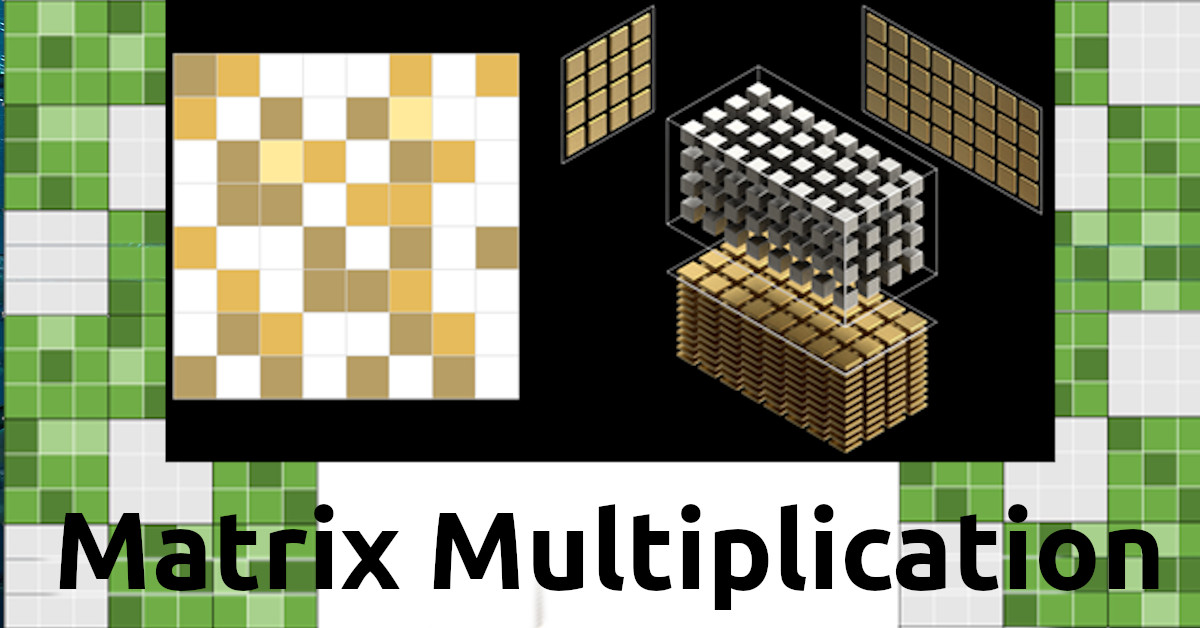
Scientific Computations with CUDA: A Guide to Matrix Multiplication
Matrix multiplication is a fundamental operation in scientific computing and data processing. It is a computationally intensive task that can be significantly accelerated using Graphics Processing Units (GPUs) and the CUDA programming model developed by NVIDIA. In this article, we will explore the concept of matrix multiplication, provide a CUDA code example for matrix multiplication, and guide you through the process of compiling and running the code.
Understanding Matrix Multiplication
Matrix multiplication is a mathematical operation that takes two matrices and produces a third matrix. Given two matrices A (of size MxK) and B (of size KxN), the resulting matrix C (of size MxN) is obtained by computing the dot products of rows from matrix A and columns from matrix B. Each element in matrix C is the sum of the products of corresponding elements in the row of A and column of B.
Code Example: Matrix Multiplication with CUDA
Below is a CUDA code example that demonstrates matrix multiplication. We'll break down the key components of the code:
#include <iostream>
// Matrix multiplication kernel
__global__ void matrixMultiplication(float* A, float* B, float* C, int M, int K, int N) {
int row = blockIdx.y * blockDim.y + threadIdx.y;
int col = blockIdx.x * blockDim.x + threadIdx.x;
float sum = 0.0f;
for (int k = 0; k < K; ++k) {
sum += A[row * K + k] * B[k * N + col];
}
C[row * N + col] = sum;
}
int main() {
int M = 1024; // Number of rows in matrix A
int K = 1024; // Number of columns in matrix A and rows in matrix B
int N = 1024; // Number of columns in matrix B
// Host memory for matrices A, B, and C
float* h_A = new float[M * K];
float* h_B = new float[K * N];
float* h_C = new float[M * N];
// Initialize matrices A and B (for simplicity, using sequential values)
for (int i = 0; i < M * K; ++i) {
h_A[i] = static_cast<float>(i);
}
for (int i = 0; i < K * N; ++i) {
h_B[i] = static_cast<float>(i);
}
// Device memory for matrices A, B, and C
float* d_A;
float* d_B;
float* d_C;
cudaMalloc((void**)&d_A, sizeof(float) * M * K);
cudaMalloc((void**)&d_B, sizeof(float) * K * N);
cudaMalloc((void**)&d_C, sizeof(float) * M * N);
// Copy matrices A and B from host to device
cudaMemcpy(d_A, h_A, sizeof(float) * M * K, cudaMemcpyHostToDevice);
cudaMemcpy(d_B, h_B, sizeof(float) * K * N, cudaMemcpyHostToDevice);
// Define grid and block sizes
dim3 blockSize(16, 16);
dim3 gridSize((N + blockSize.x - 1) / blockSize.x, (M + blockSize.y - 1) / blockSize.y);
// Launch matrix multiplication kernel
matrixMultiplication<<<gridSize, blockSize>>>(d_A, d_B, d_C, M, K, N);
// Copy the result matrix C from device to host
cudaMemcpy(h_C, d_C, sizeof(float) * M * N, cudaMemcpyDeviceToHost);
// Print a sample element from the result matrix C (for demonstration purposes)
std::cout << "Result Matrix C[0][0]: " << h_C[0] << std::endl;
// Free device memory
cudaFree(d_A);
cudaFree(d_B);
cudaFree(d_C);
// Free host memory
delete[] h_A;
delete[] h_B;
delete[] h_C;
return 0;
}
Compiling and Running the Code
To compile and run the code, follow these steps:
- Ensure you have the NVIDIA CUDA Toolkit installed on your system.
- Save the code to a file with the
.cuextension, e.g.,matrix_multiplication.cu. - Open a terminal and navigate to the directory containing the code file.
- Compile the code using nvcc
nvcc -o matrix_multiplication matrix_multiplication.cu - Run the executable:bashCopy code
./matrix_multiplication
You should see the result, which is the product of matrices A and B (matrix C), printed to the console.
Conclusion
Matrix multiplication, a foundational operation in scientific computing and data analysis, becomes a computational challenge as the size of matrices grows. Leveraging the parallel processing capabilities of GPUs through CUDA, we've explored how to accelerate this computationally intensive task. In this extended conclusion, let's recap the key takeaways and the significance of GPU-accelerated matrix multiplication:
- GPU-Accelerated Computing: GPUs offer immense parallel computing power, making them well-suited for tasks that involve massive data processing. Matrix multiplication is a prime example of a task that benefits greatly from GPU acceleration.
- CUDA Programming Model: CUDA provides a powerful framework for developing parallel applications on NVIDIA GPUs. It allows developers to harness the GPU's processing capabilities efficiently.
- Parallelism: The heart of GPU acceleration lies in parallelism. Thousands of GPU threads work in parallel to perform computations, drastically reducing the time required for tasks like matrix multiplication.
- Efficiency: The code example presented showcases how to efficiently perform matrix multiplication on a GPU. By carefully defining the grid and block sizes and optimizing memory transfers, we maximize the GPU's potential.
- Real-World Applications: GPU-accelerated matrix multiplication finds applications in diverse fields. It is instrumental in scientific simulations, machine learning, deep neural network training, image processing, and more.
- Performance Gains: The performance gains achieved by GPU-accelerated matrix multiplication are significant. Large-scale scientific simulations, data analytics, and machine learning models can see substantial speedups.
- Scalability: As the size of matrices increases, GPU-accelerated matrix multiplication continues to scale efficiently, providing a solution for handling big data.
- Optimization Opportunities: While the presented code is a basic example, there are opportunities for further optimization. Techniques like shared memory usage, tiling, and specialized libraries (e.g., cuBLAS) can further boost performance.
In conclusion, GPU-accelerated matrix multiplication is a powerful technique that unlocks the potential for high-performance computing across various domains. It's a testament to the synergy between hardware innovation (GPUs) and software development (CUDA) that empowers researchers and developers to tackle complex problems efficiently. As computational demands continue to grow, GPU acceleration remains a vital tool for driving innovation and achieving breakthroughs in science, engineering, and technology.